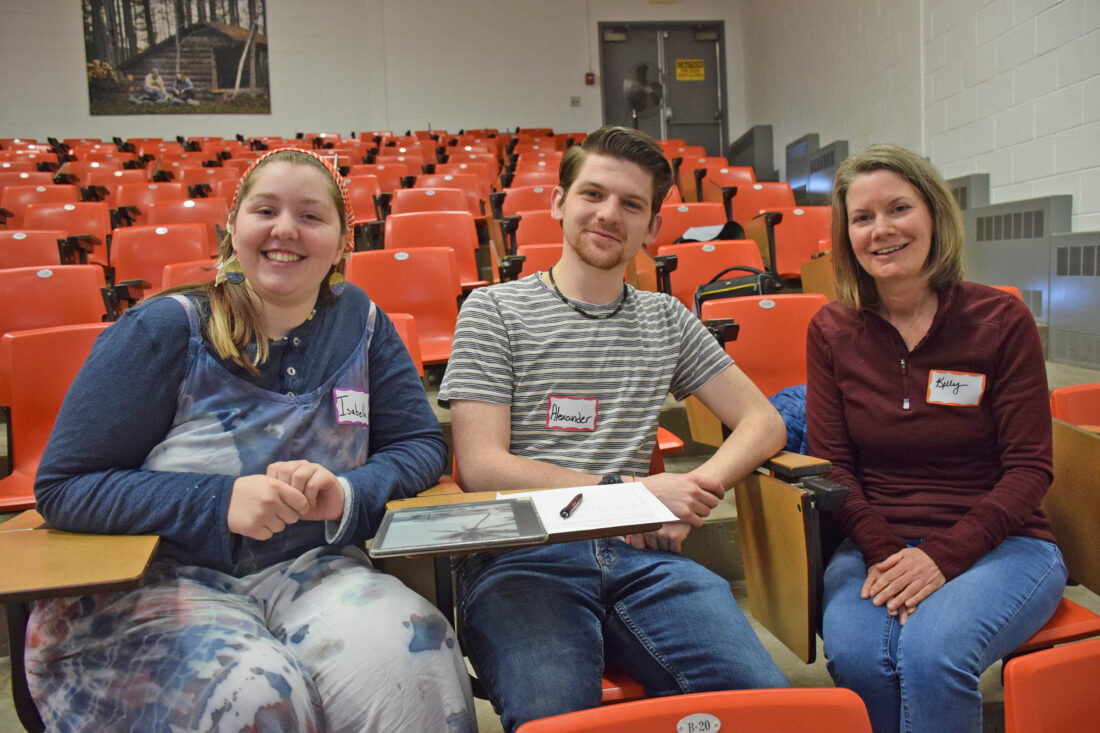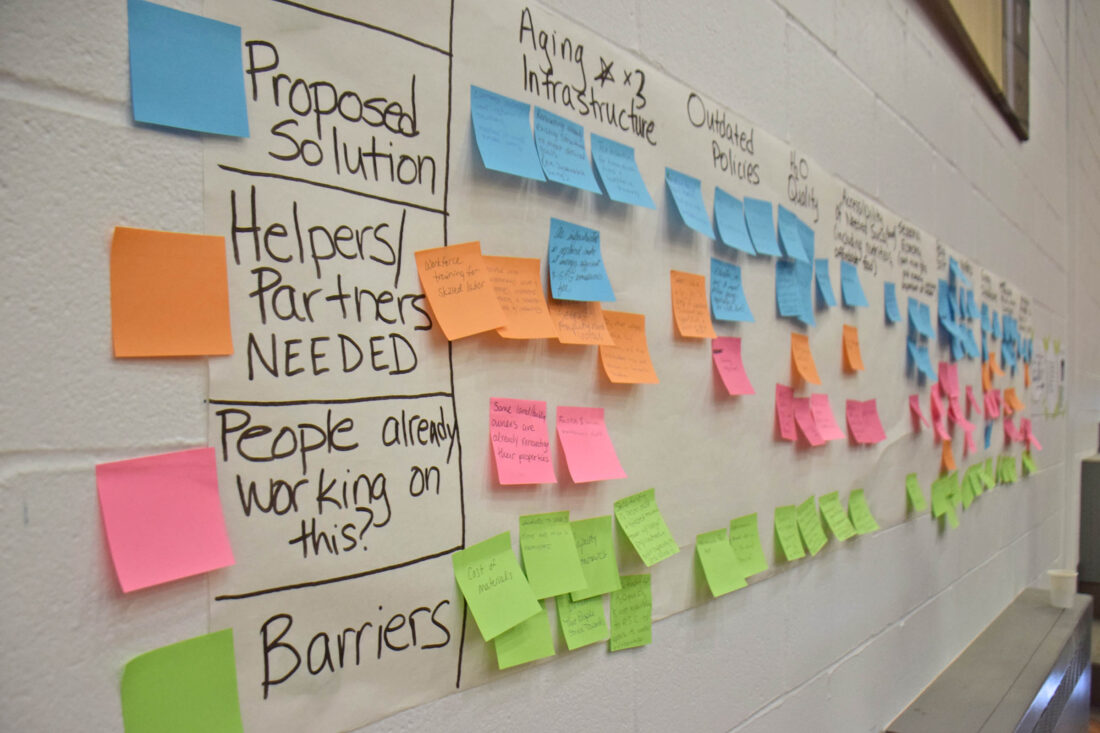Project Coordinator Sunita Halasz leads an ACORN listening session at Paul Smith’s College on Sunday.
(Enterprise photo — Chris Gaige)
PAUL SMITHS — Nothing was off the table.
That was the mentality that the Adirondack Climate Outreach and Resilience Network (ACORN) approached its 11th listening session held at Paul Smith’s College on Sunday.
The meeting drew about 30, including members of the public, PSC students, faculty and staff. The group gathered to share problems, brainstorm solutions and identify barriers to progress around climate and broader socioeconomic issues facing the Adirondacks.
ACORN is a collaboration between Paul Smith’s College, the Wild Center and the Adirondack Research Consortium. It operates on grants awarded by the Adirondack Foundation and New York State Energy Research and Development Authority. Its objective is to solicit feedback from Adirondack and North Country residents to help secure funding through identifying grants and governmental advocacy, based on the needs they hear at listening sessions — which are open to the public — according to Sunita Halasz, a project coordinator with ACORN.
She said that when it comes to advocating for resources to help build stronger communities, rural voices are all too often neglected at the state and federal levels.

Alexander Anderson, a student at Paul Smith’s College, places a sticky note containing a possible solution to the lack of youth-centered, place-based community-service curriculum in primary and secondary education today, one of the several issues identified at an ACORN listening session held at Paul Smith’s College on Sunday.
(Enterprise photo — Chris Gaige)
“The point is to not only really build capacity within our rural communities, but also to get out that rural voice because rural voices do get overlooked in New York state and in the United States,” she said.
Halasz said that through nearly a dozen listening sessions, ACORN has identified five major recurring issues North Country residents have raised. These include a lack of rural voice in government, the lack of emergency response resources in the region — largely due to cost-structures and the way first responder groups are reimbursed — affordable housing, flooding and undersized culverts, and lack of seasonal predictability in climate — which is causing disruption to an economy that is heavily based on tourism, much of which is during winter.
Halasz said that on the last point, unreliable cold and snow conditions can cause large fluctuations in tourism traffic, based on how much snow there is and accordingly, what recreation options are available locally. This can stress small businesses that may not be able to weather successive low-volume seasons.
“We really rely on winter tourism up here,” she said. “All of our 14 counties do, and when you can’t rely on that, it can make or break a business.”
She said the group, which was founded last May, has produced around 100 pages in their roadmap. Although it’s not finalized yet, as listening sessions are ongoing, Halasz said the eventual goal is to use it to channel voices in grant and policy advocacy, and overcome the inherent problem of coalescing in a region where people live physically far apart from one another.

From left, Paul Smith’s students Isabella Moyer and Alexander Anderson, as well as Kelly Langdon, of Malone, smile during a break. The trio was part of the same small group that discussed climate and socioeconomic issues facing the Adirondacks and North Country, as well as solutions, at an ACORN listening session held at Paul Smith’s College on Sunday.
(Enterprise photo — Chris Gaige)
Halasz said that although the diffuse living situations that rural areas present can complicate collaboration in certain respects, small communities also lend themselves to neighbors knowing each other on a personal basis, which naturally facilitates conversation.
“One of the things that our listening sessions do is really to promote this idea of neighbors connecting with neighbors, or social cohesion,” she said. “And we do that really well here in the North Country. We already are very connected just because we have so much weather that kind of gives us a shared identity. We also see each other face-to-face so much in our small communities and it makes us uniquely poised to be better at solving community climate resistance, because we’re so well connected.”
Halasz gave an overview of ACORN’s mission before having people break into small groups and talk with each other about the problems they believe are occurring locally. These included climate-specific issues, such as increased heavy rainfall events during the summer, as well as wider-ranging topics.
Several Paul Smith’s students at the session raised concerns about how the lack of affordable housing, coupled with a dearth of high-paying jobs, makes young people who grew up locally move away from the area to more attractive labor markets. At the same time, the problems cause people who would otherwise want to move into the area to look elsewhere.
They also brought up a paradox with employment opportunities. Contractors and other trade-based jobs are in high demand locally, they said, with many local companies booked up for months, and in some cases, years with construction projects. Having more people with skills to engineer build housing that is both affordable and sustainable, they said, is paramount to fixing the crisis while giving more people stable and reliable jobs that could support them living locally.

Dozens of color-coded sticky notes representing proposed solutions, helpers/partners needed to address the identified issues, people or groups working on the issues and ongoing barriers to solving the issues, are seen at an ACORN listening session held at Paul Smith’s College on Sunday. (Enterprise photo — Chris Gaige)
As groups shared their findings, Halasz wrote out the various problems on a large roll of paper. The session then took a more uplifting turn, as it went back into small groups, now with a new task: collaborate to find possible solutions, people or groups who are currently working to address the issues, people or groups who are needed to do so and ongoing barriers to the solutions.
Halasz said anything was helpful. For instance, if people couldn’t think of solutions in the moment, focusing and finding on the barriers could eventually help ACORN to devise a solution down the road.
The session culminated with the Paul Smith’s students presenting the various responses to the problems — which were written on sticky notes and placed under each issue — to the rest of the participants. Halasz said that out of all the sessions they have held, this one had produced among the highest volume of responses.
Isabella Moyer, one of the student participants and presenters, said this was the first ACORN session she attended, and was pleased with how it went.
“It’s definitely encouraging to see this many people want to interact about it,” she said. “It’s inspiring and hopeful.”
Moyer added that being in-person helped. She said it was much harder to be vitriolic toward someone who has a differing stance when they sitting across from them, rather than through a computer screen.
Alexander Anderson, also a Paul Smith’s student, was glad to see people putting aside their political differences in groups and focusing on the common ground that they shared in both identifying problems and coming up with solutions.
“I was worried that it was going to be oppositional,” he said. “But it was very reassuring once the conversations got started because everyone was trying to focus on solutions and just finding common ground rather than … being at each other’s throats.”
For more information on ACORN, visit adkwatershed.org/acorn.











